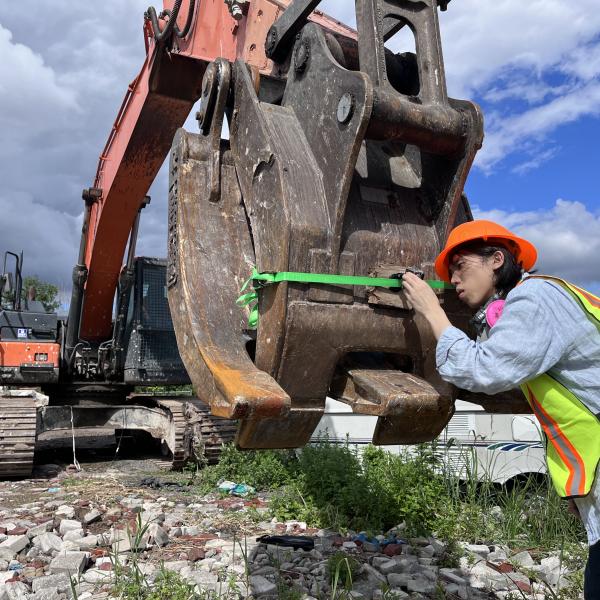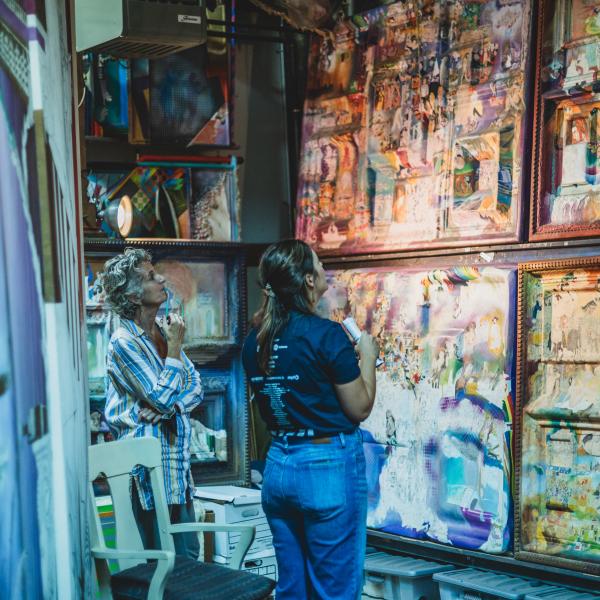Joyfully Together

The 2017 Atlanta BeltLine Lantern Parade marches along the BeltLine’s Eastside Trail. The parade first began in 2010 and has become an annual staple since its inception, with thousands participating in the family-friendly event annually. Photo by the Sintoses, courtesy of Atlanta BeltLine
Chantelle Rytter wasn’t exactly thrilled when circumstances necessitated a move from New Orleans, Louisiana, where she’d lived for more than a decade, to Atlanta, Georgia. An artist who creates lantern parades using giant puppets, Rytter recalled, “When I first moved here, I called it a soulless parking lot.” She couldn’t help comparing how New Orleans’ residents engaged their public space with the lack of similar engagement in Atlanta. In particular, it was New Orleans’ first Mardi Gras post-Katrina, a potent measure of the shattered city’s resilience and determination, that compellingly illustrated for Rytter that its traditional parade culture was comparable to a “civic wellness program doing this thing that so few things can do…. [New Orleanians] regularly occupy their public space so joyfully together.”
This started Rytter thinking about how she could bring that same community-centered culture to her new home. “New Orleans krewes see the parades as a gift to their city. So I thought that I should try to give that gift to our city. And that was rolling around in my head when the BeltLine gave a call for proposals in this brand new public space that didn’t exist yet, that hopefully our city is going to love and be connected by. The BeltLine’s connecting our in-town neighborhoods really rang a bell with me because that’s what I want to do too,” she explained.
Rytter’s story exemplifies the central mission of the arts and culture program of the Atlanta BeltLine: to give the city’s residents a way to connect in a deeper way with their community and with each other. The BeltLine itself, a series of pedestrian and bike-friendly trails built on the city’s defunct rail lines, will eventually run roughly 22 miles, touching about 45 adjacent neighborhoods on the city’s east, south, and west sides.
As Atlanta BeltLine Chief Equity and Inclusion Officer Nonet Sykes described, “The BeltLine is the largest, most comprehensive redevelopment project in the nation right now.” The project includes not only art installations and participatory arts events on the site itself, but also economic development and inclusion strategies, such as affordable housing, a façade improvement program for adjacent businesses, job creation for artists, and a legacy retention program to make sure residents aren’t gentrified out of their homes. Sykes added that “the BeltLine project hinges on a vision where all Atlantans can benefit and prosper from all of the economic growth and activity associated with the BeltLine.”

Fifth grade students and their teacher from Parkside Elementary in Atlanta’s Grant Park neighborhood worked with Art on the Atlanta BeltLine muralist Aysha Pennerman (not pictured) to create four temporary murals on the BeltLine’s Southside Trail near the school. The 2023 initiative marked the first art collaboration between Atlanta Public Schools and the BeltLine. Photo by the Sintoses, courtesy of Atlanta BeltLine
The larger organization, Atlanta BeltLine, Inc., which operates as a quasi-governmental agency, also pays careful attention to the socioeconomic demographics of surrounding communities so it can, according to Sykes, “identify what we call equity priority areas, [neighborhoods that have] higher rates of unemployment, lower median household income, higher housing cost burdens, and greater dependency on transit. We use those four metrics to help us identify targeted areas where we would invest additional resources to ensure that those communities could benefit too from all of the development that was happening. We didn’t want them to be overlooked, to not have access to all of the resources they could have to help them thrive.”
Surprisingly, given their central role now, the arts were not an original part of the project proposal. But when planners considered how they could incentivize citizens to use the converted walking trails, a concept that was still relatively new to urban spaces in 2005, arts and culture offerings, were a natural fit. Art on the Atlanta BeltLine, an exhibition of temporary and permanent public art along the walking trails, was born.
“The idea that was the birthplace for Art on the Atlanta BeltLine was to create these cool public spaces for people to activate and engage with while they’re on the trail, and that was the sole purpose. We’ve got to get people on the trail period…. [Today] there’s an expectation that when you’re out there, you’re experiencing the culture of Atlanta in its many different forms.
”Speaking from an artist’s point of view, Rytter said, “The BeltLine itself is a developer. It’s a big giant development, and they have taken the time and the money to have an art program. I feel like you can bring any idea to Art on the Atlanta BeltLine. We’ve got famous people doing expensive things and we have local people who have never stepped out before. So I think it’s fantastic that there’s a solid art program around this giant development.”
The community is invited not only to participate in the arts while on the BeltLine’s trails, but also to be part of the arts and culture planning process. As Reid noted, “We’ve learned over time to also hear what the people want to see. Atlanta has had a large, rich history and culture before there was a BeltLine. So you come into that space, you have to acknowledge that and work with that. We have a lot of processes in place to allow the community to weigh in.” The programming process also includes Atlanta’s practicing artists, such as Rytter, so that the selected work is artistically at a high level as well as inclusive and representative of the larger community. The permanent collection alone contains art work by local, regional, and nationally known artists, including visual artist Mel Chin, illustrator and muralist Aziza Andre, and multidisciplinary artist EuGene Byrd III, currently the BeltLine’s curator-in-residence.
Sykes noted that by actively engaging with Atlanta’s residents, the BeltLine’s arts and culture program—which received NEA Our Town grants in 2014 and 2015 as well as subsequent NEA grants for public artworks and performances—has helped strengthen the civic health of the community. “We allow the community to hold us accountable, and that level of accountability is then transposed to other organizations throughout the city. They’re looking to hold other city agencies accountable, and then they show up expecting the same level of engagement, the same level of transparency, the same level of feedback and input,” she said. “I think we’ve helped to elevate community engagement and accountability and transparency through the way we approach our work at the BeltLine.”

Atlanta BeltLine Lantern Parade Founder and Creative Director Chantelle Rytter. Photo by the Sintoses, courtesy of Atlanta BeltLine
The BeltLine’s deep engagement with arts and culture has also had economic benefits for the community, including its business owners and artists. Local businesses and developers are eager to work with artists, including offering them free or low-cost studio space and employing them to help beautify their sites.
Sykes said, “We are helping businesses that are located adjacent to the BeltLine refurbish or refresh the exterior of their business to make them more appealing, more inviting, increase foot traffic, and thereby increase revenue.”
Reid added, “[For businesses,] it’s not enough just for you to have the cool place to have coffee or what have you, but there has to be something visually interesting, something culturally significant as part of your development.”
Though the BeltLine has only officially been open to the public since 2008, it has already changed the character of the city. “When you have a significant infrastructure project like this, there’s definitely change that comes as a part of that…. We’ve seen amenities come to communities that historically have not seen those amenities. And so there’s definitely a lot of success that way,” said Reid.
“I believe the BeltLine is enhancing connectivity, enhancing mobility, enhancing economic opportunity, and really just positively transforming Atlanta for the better, preparing it to enter into the next century,” said Sykes. “When I came to the city, it just felt like the infrastructure didn’t support all that Atlanta wanted to be, and so I think this is the first phase of really preparing the city to be [the] world-class global city that it ideally wants to become.”
Rytter’s BeltLine Lantern Parade has now become a signature event, which has led to additional parades in other Atlanta neighborhoods. Needless to say, thanks to the BeltLine and the opportunities it has presented, she’s changed her mind about her new home. “I think that the cultural characteristics of a place is what connects people to it. When you love a place, you will behave differently and do things that you wouldn’t do if you didn’t love it. I think all of the visual, structural art on the BeltLine contributes to the sense of space and our collective character, like what we see ourselves as,” she said. “I think when we lay down joyful shared memories together in a place, it’s a blessing on that place. Beautiful things happen here.”








